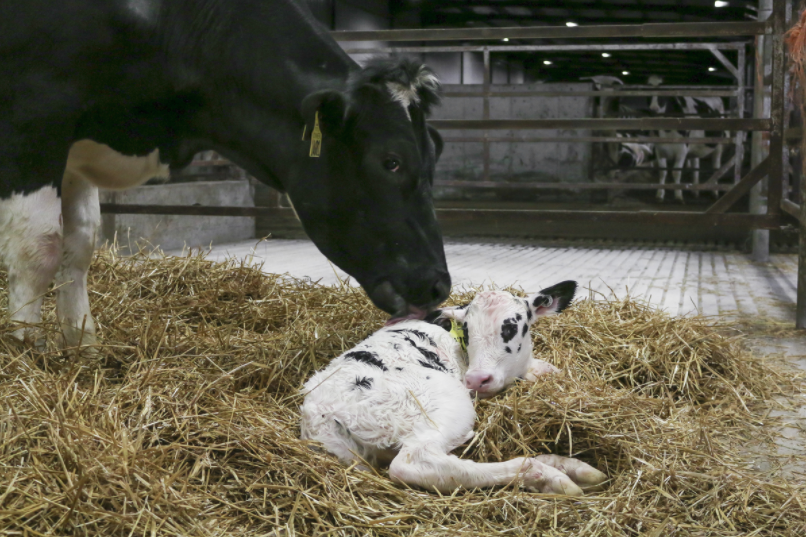Just like other animals, transition cows (cows during the last few weeks of gestation and the first few weeks of lactation) require nutrients to perform functions such as maintaining themselves, producing milk or colostrum and maintaining pregnancy. However, formulating diets to meet the nutrient requirements of transition cows is almost impossible because both daily dry matter intake (DMI) and nutrient needs are changing very rapidly during this time.
During the last several days prior to calving, daily intake decreases while at the same time, the fetus is growing rapidly, requiring extra nutrients, and colostrum is starting to be produced – which also requires very high amounts of energy, protein and some minerals and vitamins. After calving, both milk production and intake are increasing, but the nutrient demand to produce milk increases more rapidly than does DMI. Because of these challenges, in addition to describing nutrient requirements for transition cows, the new NASEM emphasizes nutritional practices which will reduce the prevalence of health disorders that commonly occur around parturition.
Compared to the previous version, average nutrient requirements for dry cows did not change greatly; however, protein and energy requirements are lower for far-off dry cows and greater for pre-fresh cows. The new equations used to calculate those requirements are more accurate than the previous ones and should better estimate the nutrient needs of both far-off and pre-fresh cows.
The previous NRC recommended increasing the energy density of pre-fresh diets by replacing some fiber with starch because it was thought it might mitigate the normal drop in intake that occurs prepartum. However, based on experiments conducted in the last 15 years, increasing the starch concentration of pre-fresh diets usually provides little benefit and may increase health disorders after calving. The 2021 committee did not recommend that practice. We know that oxidative stress increases markedly around calving. Some increase in oxidative stress is normal and is actually desirable for normal parturition – but when it becomes excessive, immune function can be inhibited. To combat excess oxidative stress, the committee recommended that pre-fresh cows be fed about 2,000 IU of vitamin E per day, which is twice what the previous committee recommended. Requirements for the other vitamins and minerals are about the same as given in the previous version.
The new publication discusses the effect of prepartum nutrition on milk production after calving. In general, the committee concluded that feeding more protein than what a late-gestation cow requires (approximately 12% crude protein) did not affect milk yield. In other words, feeding excess protein to pre-fresh cows will provide little benefit but will increase feed costs.
That was not true for springing heifers. Feeding protein in excess of that needed for maintenance and pregnancy (diets with approximately 15% crude protein) to late-gestation heifers often results in greater milk and milk protein production after calving. However, if a reasonable growth target (approximately 1.6 pounds per day in addition to the bodyweight change associated with fetal growth) is included when formulating diets for springing heifers, dietary requirements would calculate out to about 15% crude protein (CP).
The committee concluded that feeding more energy-dense diets prepartum did not affect milk yield if prepartum energy requirements were met. Colostrum yield and quality is extremely important to the well-being of calves, but the committee noted that most experiments with pre-fresh cows did not include colostrum as a response measure. Therefore, we do not know whether current nutrient recommendations are adequate for colostrum. Colostrum is extremely nutrient-dense and represents a significant but short-term need for nutrients. For example, 20 pounds of first-milking colostrum has about as much energy and vitamin A as that needed to maintain a late-gestation cow for one day.
The transition cow chapter contains an in-depth discussion of common health disorders and nutritional recommendations to reduce the prevalence of those problems. For hypocalcemia, a negative DCAD diet or a diet containing calcium binders are recommended. In addition, it is important that pre-fresh cows not be fed excess phosphorus and be fed excess magnesium. Ketosis is reduced if the drop in DMI that usually occurs shortly before calving is minimized. One way to do this is to feed high-fiber diets that just meet the energy requirements of cows during the entire dry period. The new equations developed by NASEM to estimate DMI of dry and pre-fresh cows include dietary NDF concentration, and diets with higher NDF have a lesser estimated decrease in intake prepartum than diets with lower NDF.
That transition cow chapter is just a small part of the new NASEM dairy nutrient requirement book. The book should be a useful reference for nutritionists, dairy science students and some producers. It is available for purchase at National Academies Press.








